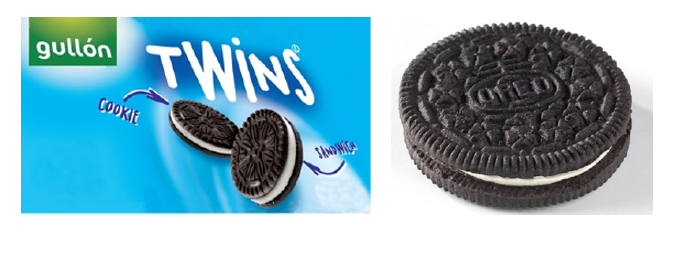The General Court of the European Union has refused to register the figurative mark `Gullón Twins Cookie Sandwich´ because Gullón was taking unfair advantage of the earlier three-dimensional mark protecting the shape of Oreo’s cookie.
In this case T-677/18, the General Court decides on the appeal lodged by Galletas Gullón against the decision of the EUIPO Board of Appeal refusing to register the following figurative mark due to the opposition filed by Intercontinental Great Brands, LLC, based on the figurative mark protecting the Oreo trademark.

The General Court analyzes if Gullón’s trademark is subject to the relative ground of refusal envisaged in Article 8.5 of the European Union Trademark Regulation. That is, if the three-dimensional mark Oreo is renowned and whether with the use without due cause of the mark applied for, Gullón intends to obtain an unfair advantage of the reputation of the Oreo cookie. To that end, Gullón claims the following:
- The three-dimensional Oreo trademark is not distinctive, as it reproduces a cookie sandwich for cookies.
- It is not renowned, as what consumers recognize is the “Oreo” mark, but not a three-dimensional cookie. In addition, the use of the shape of the product in promotional materials or packaging is not sufficient to confer a reputation.
- There is no similarity between the trademark application made by Gullón and the Oreo biscuit, since the similar elements – the shape of the sandwich biscuit – are generic, being distinguished in the dominant elements “twins” – “gullón” and “oreo”.
- The harm caused to the Oreo mark has not been proved, since they cannot claim to have a monopoly on the shape of the product consisting of a sandwich biscuit.
The purpose of the aforementioned article 8.5 of the European Union Trademark Regulation is to protect the intrinsic economic value of trademarks which, thanks to the intensive use and investments made by their owner, have reached an exceptional status in the market, i.e., the category of trademarks with reputation. In order to benefit from the protection that the Regulation confers on marks with a reputation, the proprietor must demonstrate three cumulative requirements:
- The identity or similarity of the conflicting marks, not requiring a likelihood of confusion or association, but simply the establishment of a link between the two signs by the relevant public;
- The reputation of the earlier mark; and,
- The existence of a risk that the use without due cause of the mark applied for will take unfair advantage of, or be detrimental to, the distinctive character or the repute of the earlier mark.
Said the above, the General Court in its decision confirms the distinctiveness of the shape of the biscuit, the similarity between the conflicting signs and the reputation of the earlier mark, concluding that the three-dimensional Oreo biscuit is known by a significant part of the public targeted by the goods.
Once the above requirements have been met, the General Court analyzes again if there is due cause in the use made by Gullón in order to determine if we are facing a case of ‘parasitism’ or ‘free-riding’. Firstly, it confirms that consumers will understand: (i) that there is a link between the two signs since they coincide in their figurative elements; (ii) that the Oreo cookie enjoys a reputation; (iii) that there is identity in the goods – cookies; and (iv) that the distribution channels are identical, being likely that both products may appear on the same supermarket shelf.
Secondly, it confirms the unfairness of Gullón’s use of the three-dimensional biscuit, since it is using a sign similar to the earlier reputed mark, in order to benefit from its power of attraction, its reputation and its prestige, and thus, to obtain an advantage by exploiting the commercial effort made by Oreo to create and maintain its image, without offering any financial compensation in return and without making any effort. The General Court conclude that there is no due cause for Gullón to use the mark applied.
This case is relevant because it provides additional guidelines for determining not only when a three-dimensional mark is reputed, but also when it should be found that there is a case of unfair exploitation of another’s trademark reputation that would prevent from registration, or even, allowing to request the cease in a possible trademark infringement proceedings. The battles over biscuits are continuous. Other case will be the one of Flor Burgalesa and Artiach, in their dispute over the use of `dinosaurs´. If you want to see our commentary on this, you can access here.
Beatriz Ganso
Garrigues Intellectual Property Department






